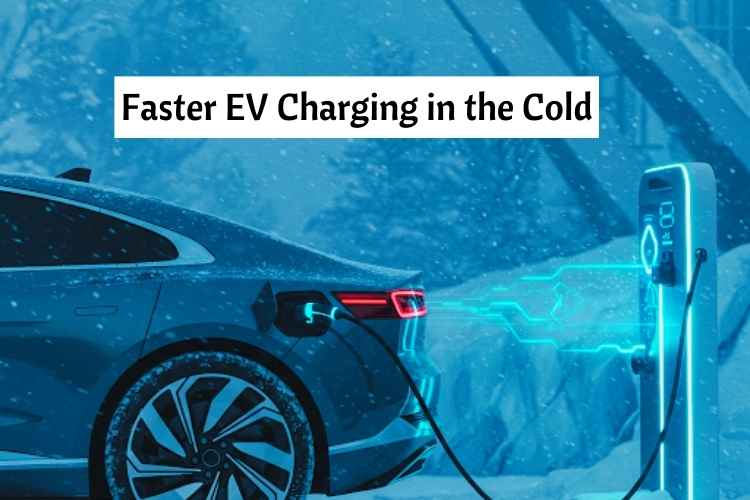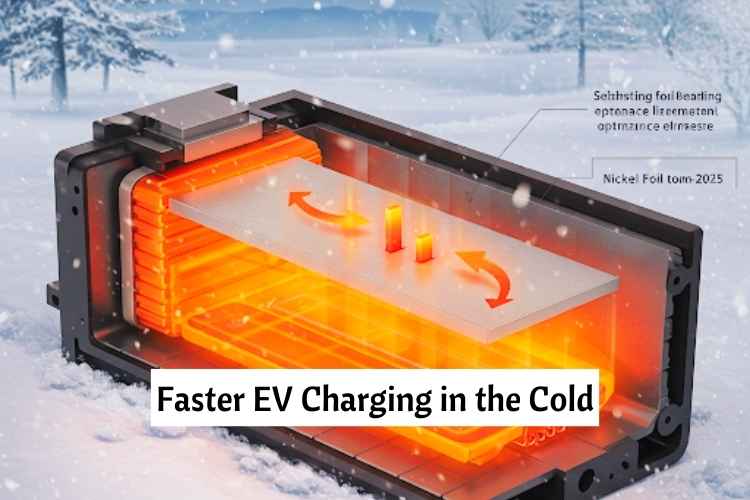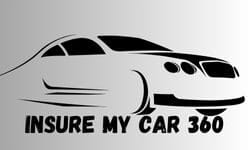Faster EV Charging in the Cold: Ask any electric vehicle (EV) owner in a cold climate, and they’ll likely share the same frustration — winter makes everything slower. Charging times drag, driving range shrinks, and battery performance drops significantly.
But 2025 is bringing game-changing breakthroughs. Researchers, automakers, and battery manufacturers are progressing toward faster EV charging at sub-zero temperatures — a shift that could revolutionise how EVS perform in cold weather.

Table of Contents
2025 Breakthroughs: How Charging is Getting Faster EV Charging in the Cold

This year, several innovations are combining to rewrite the rules of EV performance in freezing temperatures.
1. Self-Heating Battery Technology
Researchers at Penn State University and Chinese battery giant CATL have developed self-heating batteries that pre-warm themselves before charging.
How it works:
- A thin nickel foil inside the battery heats the cell quickly (in less than 2 minutes).
- This internal warming brings the battery to an optimal charging temperature even in -20°C conditions.
Case Example: In early 2025, CATL’s Qilin battery, with self-heating capability, demonstrated an 80% charge in 15 minutes at -10°C, cutting typical winter charging time in half.
2. Smarter Battery Management Systems (BMS)
EVS like Tesla and Hyundai now use intelligent battery software that “learns” your habits and prepares the battery in advance.
Features include:
- Preconditioning based on GPS: If you’re navigating to a DC fast charger, the vehicle begins warming the battery before you arrive.
- Dynamic thermal balancing: Software adjusts energy use in real time to keep the battery in the sweet spot for charging.
Real-world impact: Tesla’s 2025 software update showed up to 35% faster Supercharging times in freezing temperatures thanks to improved battery preconditioning.
3. Advanced Thermal Management Systems
Some automakers, like Lucid Motors and BMW, are using integrated heat-pump systems that recycle heat from the drivetrain and cabin.
Instead of relying on resistive heaters (which consume battery power), these systems:
- Efficiently warm the battery using waste heat.
- Maintain optimal temperature without killing range.
Test Scenario: BMW’s 2025 ix3 model sustained 90% of its normal fast charging rate at -5°C using its new thermal loop system.
4. New Electrolytes & Battery Chemistries
Scientists are exploring low-temperature electrolytes and silicon-anode batteries that naturally perform better in the cold.
- Silicon-based anodes store more lithium ions and work better at low temperatures.
- Some startups, like Enovix, are building batteries with faster cold-start performance without needing as much thermal preconditioning.
Why This Breakthrough Matters (Beyond Convenience)
| Benefit | Impact |
|---|---|
| 🔌 Faster charging in all weather | Reduces time spent at public chargers — even in deep winter. |
| 🌍 Greater adoption in cold regions | Reduces peak power loads during long, cold-weather charging sessions. |
| 🔋 Less battery degradation | Prevents lithium plating, extending battery life and resale value. |
| ⚡ Grid efficiency | Builds driver confidence year-round, regardless of the climate. |
| 🚘 More consistent performance | Builds driver confidence year-round, regardless of climate. |
Conclusion on Faster EV Charging in the Cold
For years, cold temperatures were the silent enemy of EVS. They drained range, killed charging speed, and cast doubt on whether electric mobility could truly be universal.
But in 2025, that’s changing. Thanks to smart battery design, software innovation, and cutting-edge thermal systems, faster EV charging in the cold is no longer a dream — it’s a breakthrough that’s here now.
Bhakti Rawat is a Founder & Writer of InsureMyCar360.com. This site Provides You with Information Related To the Best Auto Insurance Updates & comparisons. 🔗
